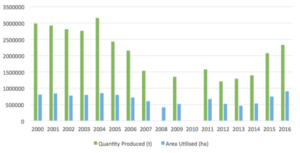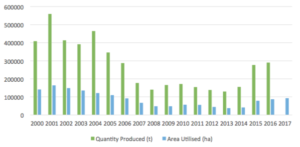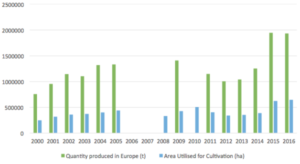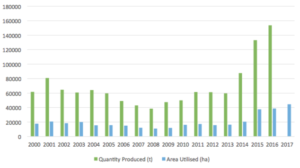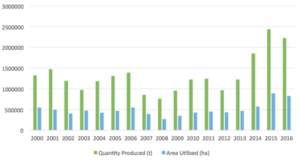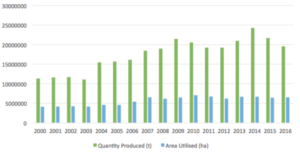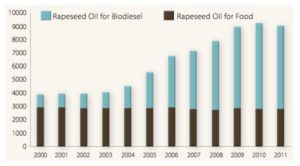Summary
Cereal production in the European Union has boomed thanks to the Common Agricultural Policy and has become today the third largest in the world with 306 million tones expected in 2018 or 14.6% of global production.
Presented on the international market – with 33.5 million tones exported or 11% of its production – in a context of increasing demand (due to cereal consumption up 40% in 15 years) this production is currently not in a “comfortable and installed” posture.
Competition in traditional international markets has been fierce since the recent boom in exports in the Black Sea region with stabilizing at 60 million tones or 1/3 of world trade. Challenges are also present within the EU, starting with stagnant yields in the West, the impact of regulation on plant protection products and the pressure of climatic hazards such as historical drought this summer.
For the industry to avoid stalling and to overcome these challenges multiple levers of action are available. Adopting a digitized grain farming will optimize the environmental and economic performance of grain farmers. Establishing a European crisis management fund in agriculture that efficiently provides for and generalizes climate insurance will make it possible to deal with the consequences of climate change and the high volatility of the markets. Abandoning tillage and adopting direct seeding could support the agronomic and economic performance of cereals as long as the technical means are or remain at the “rendezvous”.
In such a context, the value chain must be able to rely on a CAP that better protects farmers’ income in a context of high price volatility and that further supports investment in innovation for a transition to successful models. This note presents the challenges and recommendations for modernizing the industry and shaping a CAP with strong common tools coupled with the necessary and targeted flexibilities to build an ambitious strategy that effectively articulates community tools and national or regional actions.
Table of contents
I – The European cereals sector: characteristics and challenges…………………………… 1
A Panorama of the European industry………………………………………………………………….. 1
a/ General data…………………………………………………………………………………………………. 1
b / Importance of the sector for the competitiveness of the livestock and ethanol sectors 3
B External challenges……………………………………………………………………………………………. 3
a / The rise of Ukraine……………………………………………………………………………………….. 3
b/ The Russian boom…………………………………………………………………………………………. 4
c/ Global demand, the challenge of food security……………………………………………… 5
C Internal challenges…………………………………………………………………………………………….. 6
a / Lower income of farmers……………………………………………………………………………… 6
b / Volatility of the market……………………………………………………………………………….. 7
c / Climatic risks……………………………………………………………………………………………….. 7
d / Availability of plant protection products…………………………………………………….. 8
e / Environmental sustainability and crop yield………………………………………………… 9
f / Current reform of the CAP…………………………………………………………………………….. 9
II-Succeed in a fierce competition……………………………………………………………………… 10
A Market expectations……………………………………………………………………………………….. 10
a/ Becoming a global leader in the world again………………………………………………. 10
b / Do not lose weight on the EU market…………………………………………………………. 11
B Action levers……………………………………………………………………………………………………. 12
a / The digitalization of agriculture…………………………………………………………………. 12
b / Insurance tools for managing volatility, European fund for major crisis management in agriculture. 12
c / Genetic improvement to meet societal expectations and adapt to climate issues 13
d / Cultural methods……………………………………………………………………………………….. 13
e / Logistics aspects: storage and transport………………………………………………….. 14
III- Conclusion: a winning strategy for the EU cereals industry………………………… 15
A The first pillar………………………………………………………………………………………………….. 16
B The second pillar……………………………………………………………………………………………… 17
C Outside the pillars…………………………………………………………………………………………… 18
I – The European cereals sector: characteristics and challenges
A Panorama of the European industry
a/ General data
State of play in 2017 – 2018
Considering together the three main cereals produced – namely wheat, barley and grain maize (85% of EU cereals production in 2016) – the European Union, with a production of 275.2 million tones or 14% of world production, ranks third behind China and the USA. Almost 48 million hectares are cultivated for this purpose, representing 27% of the EU’s UAA. 33.4 million tones will be exported during this year or almost 1 tone of cereals out of 8. The economic weight of cereal production is about 46.8 billion euros.
With 151.2 Mt of wheat (hard and soft), the EU is the world’s leading producer ahead of China and Russia. 27 million hectares are cultivated, with an average yield of 5.6 t/ha (soft wheat). 24.4 million tons will be exported during this year.
The EU is also the world’s largest producer of barley, at 58.8 Mt, ahead of Russia and Australia. 12.3 million hectares are cultivated, with an average yield of 4.8 t/ha. 8 million tones will be exported during this year.
Finally, for maize, with a production of 65.2 million tones, the EU ranks fourth in the world, behind the USA, China and Brazil. 8.6 million hectares are cultivated, with an average yield of 7.6 t/ha. 1 million tones will be exported during this year.
Trends since 2000
From 246 tones to 277 million tones (Mt), European cereal production – wheat, barley and maize – increased from 12.5% in the EU to 28. Cropping decreased by 2.2 million hectares (-4.5%), but average yields increased by 1.25 t/ha (+ 25%). It is in Central European Member States (EU-13) that this increase has occurred with an average of 92.5%. While this increase was only 5.6% on average in Western Europe (EU-15). As for exports, they rose – between 2012 and 2017 – from 28 Mt to 33.5 (+ 21%), or from 13.5% to 12.1% of production.
Since 2000, European wheat production has risen from 133.4 Mt to 152.3 Mt (+ 14.2%), and the area decreased from 26.8 million hectares to 26 million hectares (-3%). Average yields increased from 5.3 to 6.1 t/ha (+ 14%) but this hides a clear disparity. Yields (soft wheat) stagnated in the EU-15 (from 6.7 to 6.8 t/ha (+ 1.5%)) and strongly increased in the EU-13 (from 3.2 at 5.1 t/ha (+ 59%)). As for exports, they increased from 19.2 to 23.5 Mt (+ 22%) between 2012 and 2017.
Since 2000, barley production has stagnated, falling from 60.3 to 59.3 Mt (-1.7%), on areas that declined by 15%, from 14.2 to 12.1 million hectares. Yields increased by 15.3%, from 4.25 to 4.9 t/ha with a strong geographical disparity again. They stagnated from 4.8 to 5 Mt (+ 4.2%) in the EU-15 and grew from 2.5 to 4.4 Mt (+ 76%) in the EU-13. The volume of exports also increased, from 10.4%, from 6.7 to 7.4 Mt (2012-2017).
Finally, maize has experienced the highest growth over the period in the EU. Although the surface area decreased by almost 14%, from 9.7 to 8.4 million hectares, the volumes produced and exported grew strongly, respectively by 24.6% – from 52.7 to 65.5 Mt. – and 45.4% – from 1.8 to 2.6 Mt – thanks to the clear improvement in yields, from 5.4 to 7.8 t/ha (+ 44%). Here again, yields in the EU-13 rose the most, from 2.6 to 6.3 t/h (+ 142%), while growth was 11% in the EU-15, from 9.1 to 10.1 Mt.
b / Importance of the sector for the competitiveness of the livestock and ethanol sectors
With 157.4 million tones consumed in 2016-17 (57% of production), cereals produced in the EU rank first in the protein diet of the EU livestock sector (59%). This is followed by 84.1 million tones of co-products from cereals and oilseed crops (31.5%) and 18.3 million tones of imported cereals (6.9%).
Note: Of the 84.1 million tones of co-products, 18.3 million tones (22%) were soybean meal imported from North and South America.
Of the 25.8 million tones of feedstock consumed by the ethanol industry in 2016-17, cereals produced in the EU accounted for 13.2 million tones (51%) and sugar beet 12.6 million tones (49%). 4.5% of European cereal production was consumed by the ethanol sector.
B External challenges
The Black Sea Basin has grown considerably over the past five years, with Ukraine and Russia in the lead, currently accounts for 1/3 of world grain trade (60 million out of 180 tones).
a / The rise of Ukraine
After a collapse following the dismantling of the USSR, Ukraine is on its way to becoming Europe’s “bread basket” again. Indeed, the reforms of its agricultural sector now give Ukraine the means to fully exploit its considerable natural advantages.
First of all, there is the remarkable fertility of the famous “black soils” or “chernozom”, which is rich in potash, phosphorus and trace elements due to a high percentage of humus. In addition, there is a notable topographical advantage – very large cultivable plains that account for 90% of the national surface – and a favorable climate for growing cereals. The Useful Agricultural Area (UAA) amounts to 70% of the territory, i.e. 42 million hectares
After that, there is the considerable effort made to restart the production apparatus.
The independence of Ukraine in 1991 was accompanied by a dismantling of the Soviet apparatus that had fallen into disuse followed by a complete collapse of the agricultural production apparatus. In 1999, a law laid the foundation for renewal, allowing the almost total liquidation of collective farms and the first steps towards land privatization. Very low annual rents, a very favorable tax system for agricultural enterprises was established in 1998, virtual VAT exemption in 1999, and panoply of state aid to Ukrainian farms attracted foreign investors. In Ukraine, low production costs can be found (2 to 3 times lower than France for example) in particular thanks to very low fixed costs and regulations on the use of pesticides that are less stringent than those of the EU.
The increase in volumes produced and exported has also been facilitated by joint support from FAO and the EBRD. This has facilitated dialogue between the public and private sectors, and the creation of a more favorable political environment for the arrival of foreign investors. This joint support has also trained many Ukrainian farmers for a better crop protection management and improved crop storage.
Finally, the decline in the national consumption of cereals in recent years increases the volumes available for export. The maritime facades on the Black Sea and the Sea of Azov favor the export activity.
This is a real agricultural revolution that the country has been experiencing for 20 years, and which led in 2009 to the world leader in barley and sunflower exports, in 2nd place for rapeseed, 4th in maize, 6th for wheat and 8th for soybeans. Since 2010, cereal production has increased 55% to 64 million tones in 2017 (26 of which are wheat) and exports 284%. 50% of the volumes exported are destined for Asia, and 30% of the EU, with which Ukraine has concluded an association agreement that came into force in September 2017. It should be noted, however, that this country, like Russia whose evolution is analyzed below, is particularly subject to the impacts of climatic hazards, generating very large variations in the quantities produced from one year to the next.
b/ The Russian boom
Russia’s agriculture is also booming. Here too, it is based on natural assets. The western part of this “state-continent” is a vast plain, where black soils are also present, especially in the southern part. But if Russian agricultural production has exploded in the last 3 years, it is mainly due to political will. Following the economic sanctions of the United States and the EU on the Russian energy sector in 2014, Russia responded with sanctions on a wide range of imported food products. The sanction extended to Turkish food commodity after the destruction of a Russian aircraft in Syria. The sanctions were accompanied by the announcement of the national goal of food self-sufficiency by 2020.
To achieve this goal, local and foreign investments are greatly enhanced by tax incentives. Modern technologies, the supply of machinery and fertilizers has been widely deployed. In addition to having exceeded the US harvest quantitatively since 2015, Russian wheat production is favored for export by higher protein content. This is due in particular to the variety breeding efforts in Russia, to obtain nowadays winter wheat varieties adapted to the rigors of the climate and having a protein content of up to 15 to 18% while maintaining yields high of the order of 100-120 q / ha.
The available space is also an asset for Russia to reach its goal of food self-sufficiency. It has undertaken the recapture of millions of hectares of agricultural land abandoned since the fall of the USSR.
The results are clear: the amount of Russian wheat exports in 2015 was $ 20 billion. At the same time, the share of EUA in the international wheat market increased from 50% in the 1970s to 15% in 2017. And Russia reduced its international food purchases by 40% between 2013 and 2015.
Initially estimated at 85 million tones, the 2018-19 Russian wheat crop will be smaller but still expected to reach 70 Mt, and exports 35 million tones.
c/ Global demand, the challenge of food security.
The food crises, that the world has experienced since 2007, and the already recognized impacts of climate change have reminded us that the food issue does not belong to the past but that it is a current issue that organizations such as FAO regularly and consistently recall.
This must be a topical concern for the European Union, which must be to:
- produce to ensure sufficiently effective independence for European citizens;
- produce responsibly and sustainably in a world where natural resources are fragile and limited. Responsible: by refusing to outsource to other parts of the world our resource management duties. Sustainable: because we are indebted to future generations for their ability to feed themselves and evolve in quality spaces;
- contribute to global food security by both developing regional agriculture through development policy and being a reliable supplier of global markets. Indeed, as the only major agricultural area in the world with relatively stable production conditions, the European Union has a special responsibility: to contribute regularly to the supply of structurally demanding global markets. And all the more so because the stability of world markets is a decisive element:
- the development of agriculture in less developed regions in an open world.
- the geopolitical stability of structurally deficit regions by their ability to provide their populations with sufficient and affordable food
- the ability to help limit migration crises.
The European Union and its agricultural sectors must put themselves in a position to respond in a sustainable way to the increase in global demand for food and particularly in the case of cereals intended for human consumption, which is an unavoidable and often basic source of food for whole regions, but also to have the capacity to be present in the other market segments where demand is growing (starch plants, malting plants and animal feed). It is an economic responsibility and also a major political responsibility as well.
C Internal challenges
a / Lower income of farmers
Several factors are responsible for the decline in income experienced by EU cereal producers in recent years.
First, there is the influence of global market parameters. In the case of soft wheat, the world supply is slightly above demand since 2015, which leads to low prices in the face of production costs and to compensate producers. The low yields in the EU this year (2017-18), but also in Russia, Australia and the United States, reversed the trend and therefore allowed the price of common wheat to rise to more than 200 euros per tone in Rouen.
At the same time, the cost of growing cereals has increased, mainly due to plant protection products. In some Member States, this expenditure item has increased for farmers by 40% in 20 years because of higher and higher certification costs, and increasing taxes for diffuse pollution.
The increase in the cost of energy as well as the need for more and more precise equipment and sophisticated equipment are added.
With regard to Community aid, the decrease is first of all due to a progressive erosion of the value of direct payments in recent years, accentuated in the Member States, which have made the choice to transfer large amounts of aid from the 1st towards the 2nd pillar. Grain farmers are also affected by the choice of Member States to opt for CAP extra-decoupled subsidies for the first hectares, which particularly impacts large farms in intermediate zones with an already fragile economic balance.
b / Volatility of the market
A few years ago, the cereal market could be described as “flat” and relatively predictable. The prices reacted especially to the jolts of the weather. Increased demand, higher oil and freight costs and financial markets have increased their share of volatility. As for the jolts of the weather, they are now more frequent with larger amplitude due to global warming and stronger reactions from largely financialized markets.
Price variations are now characterized by their suddenness and brutality. From about 15 euros per ton over a campaign, the range can now exceed 100 euros per ton.
c / Climatic risks
Current climate change is causing an increase in the frequency of “extreme events”, whether it is to be precipitation, temperature, or unusual winds. For agriculture, this usually results in reduced yields and greater variability of these.
Cereals, particularly durum wheat and winter barley, are particularly subject to the phenomenon of lodging, which the stormy or beating rains favor, and which causes a loss of yield, a decline in grain quality and an extension harvest time.
Unusually heavy rainfall causes the soil to become saturated with water, disrupting the extension and functioning of the root system.
On the other hand, yields are also impacted by drought, especially in areas where soils are superficial with little useful reserve, and during cereal run-off. The drought in part of Europe in the summer of 2018 is an example.
Faced with these growing threats, farmers are currently deprived, especially because of a development that remains low on climate insurance.
d / Availability of plant protection products
Like any crop, cereals require protection against pests, whether they be micro or macro organisms, and to promote weed cultivation. But farmers are now facing a scarcity of approved substances, an increase in pressure due to climate change and therefore face the challenge of finding effective alternatives quickly.
With regard to insecticides used to protect crops, the current challenge for farmers is the neonicotinoid class, which has been widely disseminated since the discovery in 1985 of imidacloprid. These insecticides have taken the place of organochlorines and organophosphorus such as DDT and have become the most used insecticides in the world because (being used mainly in seed coating) prophylactically they prevent the spread of aerial spraying. But because of their low biodegradability and toxicity to insects, they are concentrated in food webs and are mentioned as a cause of death in pollinating insects. EFSA confirmed this danger in its conclusions in February 2018 for three types of bees evaluated.
On 27 April 2018, the majority of European Union states voted to ban three neonicotinoids (clothianidin, imidacloprid and thiamethoxamur) from 2019 for all field crops in the EU with the only exception is greenhouse use.
The cost of banning neonicotinoids for rape cultivation in the EU has recently been estimated at 900 million euros per year. On wheat and barley, imidacloprid makes it possible to avoid yield losses of the order of 20 to 30% caused by dwarfing jaundice.
Regarding the herbicides used for grain farming, the main subject is related to the debates that exist on glyphosate. While the license to exploit the molecule (discovered in the 1950s) came to an end in December 2017, Member States voted in November for a five-year extension. In October 2017, the European Parliament voted – in a non-binding manner – to phase out glyphosate by 2022.
To this day, such a ban would push most European farmers to use more expensive and sometimes more dangerous herbicides, and return to weeding through tillage with its environmental consequences. The extra cost would be real. The average use of this product is for Belgium of 1.81 kg per hectare
and 1.56 kg for the Netherlands against the 1.10 kg for France or the 1.00 kg for Germany. For comparison, the extra cost has been estimated for French agriculture at 2 billion euros per year.
e / Environmental sustainability and crop yield
In agriculture, the main compartments of ecosystems concerned by sustainability are cultivated soil and water.
Some soils in cereal areas in the EU suffer from subfertility[1]. Several causes are cited to explain this trend, such as shorter rotations, decreased use of organic amendments, excessive nitrogen inputs, which favor organic carbon mineralization, and deep plowing, which disrupts microbial life in the soil therefore the synthesis of nutrients available to plants. In 2008, the European Commission estimated that 45% of European soils had a very low organic matter content, with less than 2% organic carbon, in southern European countries, but also in France, the United Kingdom, Germany and Belgium[2].
In several EU cereals countries, particularly the EU-15, cereal yields have at least stagnated over the past 15 years. In this respect, there are more hypotheses than certainties. The reconversion of good cereal lands into urbanized areas, and at the same time, the reversal of grasslands in areas less optimal for cereals is a hypothesis. The depletion of some soils in organic carbon is another[3].
The use of herbicides for the control of weeds is receiving increasing attention because of the risk of runoff from these surface products. [4]
f / Current reform of the CAP
In the context of a decline in the profitability of the sector, the budgetary and reform proposals of the CAP accentuate the threats to the cereals sector. They would cumulatively result in an average decline in European farmers’ income of between 16 and 20%. On one hand, the impact of the 12% drop in the CAP budget (constant euros) would cause a drop of more than 8% in the Community average income, with particularly strong negative effects for the arable crops sectors, where Direct payments represent a significant part of income. For the cereals and oilseed crops sector, the Commission’s impact assessment estimates a 6% drop in income in the case of a 10% reduction in income support. On the other hand, according to the European Commission’s own admission, in its impact study, the reform proposals presented on 1 June would generate an additional drop of between 8 and 10% of agricultural income according to the options chosen by the Member States.
Such a strategy would inevitably lead to the exit of farmers with the abandonment of territories especially in intermediate zones, as well as an expansion of farms. It would slow down investment capacity and generational renewal, despite the tools proposed for young farmers who could not compensate for the decline in income announced elsewhere.
As for the new implementation method proposed in the reform of the European Commission, such an evolution – which opens the way to a renationalization with a major transfer of responsibility for the first pillar to the Member States – would severely put in competition their regulatory frameworks with of course advantages, in terms of competitiveness, for the less-involved in environmental matters. This development would also be a shift from the CAP towards a programming mainly managed in a bilateral relationship between national agricultural administrations and the services of the European Commission instead of the direct relationship between EU co-legislators and its beneficiaries, farmers.
II-Succeed in a fierce competition
A Market expectations
a/ Becoming a global leader in the world again
While competitors in the Black Sea are in full conquest of grain export markets, particularly with regard to the first grain exported, namely wheat, the European Union has fallen sharply over the past three years. All cereals combined, its exports fell by almost 30%.
The share of soft wheat of EU origin in imports fell by 19% in Morocco, 49% in Cameroon and 52% in Senegal between 2015-16 and 2016-17.
For EU cereal producers, if there is indeed a challenge in terms of grain quality, linked to the requirements of bread making, a substantial challenge lies in the quest for increasing competitiveness. Indeed, lower protein and gluten levels of EU wheat can be inexpensively corrected in importing countries. It is in fact by their very low prices that make the difference for the Russian and Ukrainian producers and the very quickly gained export markets. The challenge is such that, in order to be raised, it requires an increase in yields by EU producers and a reduction in operating expenses.
b / Do not lose weight on the EU market
The first consuming area for cereals of EU origin is the European Union itself. There is therefore also a strong challenge of competitiveness of EU cereals within itself. And this challenge is increased tenfold by the external supply more and more abundant and quality.
The EU imports of all cereals have increased by 137.5% between 2009-10 and 2016-17.
The competitiveness of European cereals in the EU market itself inevitably raises the question of the rules applying to imports.
The European Union has adopted one of the highest standards in the world in terms of both social and environmental rules. What about imports?
To be positive, the opening of Community markets presupposes that the same rules apply to European productions and imports. It is certainly true of the relative competitiveness of European farmers and the respect of European Union consumers who legitimately believe that imports accepted on the European territory present an equivalent level of requirements.
However, it must be noted that this is not the case. The example of imported organic products is striking. Recent cases in the animal sector for South American products are in mind. In the plant and cereals sector, divergences in authorized or unauthorized cultivation routes, authorized or unauthorized varieties …. tend to be accentuated, while in parallel trade negotiations lend little or no attention.
B Action levers
a / The digitalization of agriculture
In order to gain competitiveness and sustainability with an increase in yields accompanied by a reduction in their operating costs, EU grain growers have a privileged solution: the digitization of agriculture.
Digitization of agriculture is a way to optimize the use of treatments on crops. The aim is to use digital technologies and geolocation to better characterize the soils of the farm and to take into account intragroup heterogeneity thus bringing “the right dose of inputs-water, fertilizers, phytosanitary products – to the right place and at the right time”. Among the inputs, phytosanitary treatments in particular have high costs both economically and environmentally. It is therefore an absolutely central position to achieve the dual performance objective of farms.
Studies in a network of farms on wheat and maize are already showing tangible and promising results in terms of benefits per hectare (from 80 to 200 euros/ha) and reduction of inputs (from 30 to 70 %) (Leader Farms, InVivo). In Greece, an experiment carried out on 9 pilot sites – 3 devoted to arboriculture and 2 to arable crops – estimated that the average savings achievable for plant protection products could reach 63%.
b / Insurance tools for managing volatility, European fund for major crisis management in agriculture.
In the context of the current CAP reform, there is no further progress in the tools needed to ensure the resilience of farms in the face of climate hazards. The advances offered by the Omnibus – the loss rate for the triggering of mutual funds and climate insurance increased to 20% (instead of 30%), and the co-financing of premiums increased to 70% (instead of 65%) – are recent and are hitting on the national budget trade-offs of CAP means to allocate or not to risk management. This management must become a priority to effectively ensure the economic resilience of farms.
The reform of the crisis reserve to make it multiannual and thus more operational is proposed, but no sufficient means are foreseen to constitute a fund with sufficient resources. There is also an important gap that the Community legislator has to fill.
The establishment of a European Crisis Management Fund in agriculture, financed by an adequately equipped multiannual crisis reserve, must be carried out in order to reduce the cost of reinsurance for climate insurance and take over IST tools from the outset when risks become deep crises (see related Farm Europe note).
At the same time, the next CAP should recognize the value of encouraging farmers to set up precautionary savings. If the tax incentive related to such a device is the responsibility of the Member States, it would be appropriate for the CAP to hold at the level of the European Union what constitutes legally and in accounting such precautionary savings, as well as some basic principles for simple use of this savings.
c / Genetic improvement to meet societal expectations and adapt to climate issues
In the late 1960s, a wheat-breeding program aimed at replacing fungicide treatments with through the use of disease-resistant varieties has increased the genetic diversity of wheat by introducing resistance to rust and trampling.
Today, the selection work focuses on a global approach to hardiness, by working on resistance to diseases, on a better valorization of the available nitrogen, on the competitiveness vis-à-vis weeds, or the tolerance to drought.
In terms of the methods available to carry out the improvement work, the possibility of using new breeding techniques in the EU remains a subject of question to which the Commission and the co-legislators must have the courage to harness following the reading of the current regulation made by the Court of Justice of the EU in late July.
d / Cultural methods
Cultural practices and especially tillage are a way to try to regain growth in yields. A meta-analysis published in October 2017, based on work conducted in 62 regions, has confirmed worldwide that non-tillage generates more microbial biodiversity itself allowing a better fertilization of the soil in assimilable mineral elements by the plants[5]. Another study, conducted in Switzerland from 1994 to 2004, revealed significantly higher yields of pulses and cereals in direct seeding[6].
However, no-till requires management of weeds and the destruction of the majority before planting, otherwise farmers will feel the need to return to deep plowing.
e / Logistics aspects: storage and transport
Every week, around 4 million tones of cereals and oilseeds worth € 1 billion circulate in the EU. Hence the importance of ensuring optimal storage and transportation of these goods, in order to avoid supply shortages and increased price volatility.
Storage
Less than 15% of the cereals produced are self-consumed on the farm. Everything else is marketed to downstream companies, be they processing or exporting, and so it depends on the collection and storage centers. Storage is an essential link in the logistics chain that enables the EU to play its role in stabilizing the world’s food supply.
Storage capacity for COPs in the EU increased by 20% between 2005 and 2015, reaching 359 million tones, while production increased by 11% to 346 million tones. However, a risk remains in places, calling for necessary investments. They are all the more necessary, as price volatility requires strategic management of stocks and therefore increased capacity. In Central Europe, deficits faded (by 3.9 Mt in Poland), turned into a surplus (of 5.3 Mt in Romania), and even overcapacity increased (in Hungary and Bulgaria). In Western Europe, only Spain managed to obtain a substantial capacity surplus (3 Mt). It is in Denmark, the United Kingdom and Germany that capacity deficits have deteriorated the most.
To address bottlenecks, the appropriate location of additional storage capacity (eg in key transport hubs or export terminals) and access to an adequate logistics infrastructure are of critical importance. Access to public funds more diversified than only those of the EAFRD appears necessary for this.
The transport
Roads, railways and inland waterways play different roles in the transport of COPs, and are often combined. For the three types of transport and the four main traffic corridors of the COPs (Rhine-Danube, Rhine-Alps, Baltic-Adriatic and North Sea-Baltic Sea), bottlenecks persist.
The improvement of the channel conditions of inland waterways, especially along the Danube – 18 bottlenecks have been identified – presents important investment opportunities, especially so that the growing Romanian, Hungarian and Bulgarian productions are better valued. Future investments should also focus on improving the interoperability of railways in order to improve efficiency and reduce waiting times in cross-border terminals, particularly in Germany and Austria. Future investments should also aim at improving regional transport connectivity, to address congestion problems on motorways and railways by extending capacity to critical locations and sections – such as Alpine crossings to Italy – and the construction of bypass routes.
III- Conclusion: a winning strategy for the EU cereals industry
European agriculture faces common challenges that can only be solved effectively if Europe is united.
Community coherence in financial support tools for farmers and related environmental objectives is therefore essential. On one hand, it makes it possible to avoid a competition, which would turn to the advantage of the less attentive as for the respect of the environment. On the other hand, it avoids the concentration of aid on targeted sectors in order to compete with these sectors in the other Member States.
The excessive level of subsidiarity and flexibility, the fragmentation of the policy framework, as well as a reduced level of ambition with regard to the CAP budget, is all elements that could transform the EU agricultural market into a battlefield. This one would see 27 different agricultural strategies to be measured between it, or even to face each other.
With the adoption of the European Parliament’s report on the Future of the Common Agricultural Policy on 16 May 2018, MEPs opted for a balanced approach calling for a “reasonable level of flexibility within a strong common framework of rules, the basic standards, intervention tools, controls and financial allocations agreed at European level by the co-legislator to ensure a level playing field for farmers”. They stressed the need to secure the direct relationship between EU co-legislators and beneficiaries – farmers – and not to transfer most of the management of the first pillar to the Member States.
The winning strategy for the EU cereals industry must keep this solid base at Community level, within the first pillar, while retaining the necessary flexibility for adjustments at local level.
This winning community strategy, driven by the CAP, should be the ambition to take all European agriculture towards double performance over the next 7 years.
Recommendations, based on different challenges and aiming to embody the dual performance in the CAP are presented below.
A The first pillar
Recommendation n°1
The guarantee of a minimum of 60% of the first pillar (before transfer) devoted to the financing of basic decoupled aids is a necessary measure in the face of the challenge of the fall in cereal income, given the importance of CAP aids in income cereal farms. Without this, cereal area risks falling sharply – up to 7% according to the Commission’s impact study – in favor of a reallocation to other crops or even an agricultural abandonment.
Recommendation n°2
The creation and the adequate endowment of a multi-year crisis management fund is a key point, alongside climate insurance, ISTs and precautionary savings to effectively meet the challenges of climate change and price volatility.
Recommendation n°3
Promoting digitized agriculture in the first pillar, by including a lump-sum incentive for the transition to dual performance in the Eco-Scheme, should be a priority of EU agricultural policy. This means should be favored to achieve double performance and thus meet the following three challenges: that of export competition on the globalized market, the gains in competitiveness obtained, environmental sustainability and regulatory pressure on phytosanitary products by optimizing inputs.
Recommendation n°4
Recognize within the first pillar the actions taken in the field of agro-ecological transition of farming systems that maintain and develop the production capacity of the European Union.
B The second pillar
The second pillar of the CAP should be mobilized as a priority to support the investment and training of farmers engaged in the transition of dual performance.
Recommendation n°5
Prioritize the mobilization of MAEC, investment and training tools – within the second pillar – farmers making the transition to double performance. This is a prerequisite for a broad expansion of digital agriculture. Such a technological revolution can only occur with human accompaniment at the height of the changes.
Recommendation n°6
Recognize complementarity and the necessary balance between the environment and the economy in the 2nd pillar of the CAP by adopting a double rule of at least 30% of the funds towards environmental measures (measures in favor of less-favored areas included) and at least 30% of 2nd pillar’s funds towards economic measures (investments, training, advice, risk management).
Recommendation n°7
The allocation of insurance tools for climate risk management and Income Stabilization Tools must be a priority for the Member States in their implementation of the CAP, to face the challenge of increasing price volatility, as the financialization of markets and climate hazards favor.
Recommendation n°8
The introduction of strong measures in the second pillar in favor of development investments for varietal improvement of cereals, for innovation investments in digital technology, robotics and bio-control, is a measure complementary to cope with climatic hazards.
Recommendation n°9
The promotion of cooperation between the actors of the cereals sector and the public authorities in the Alps, the Danube and between France and the Benelux is necessary to solve the logistical challenges that threaten the flow of cereals.
C Outside the pillars
Recommendation n°10
Maintaining the CAP budget allocation at the current level of the EU-27 is an essential measure to participate in the construction of a strong and competitive European cereal agricultural sector and effectively addressing the challenges of sustainability with the digitization of agriculture and an adequate management of risks and crises.
Recommendation n°11
As a prerequisite to any commercial agreement, put the requirement of respect for European rules and production standards (environmental and social) by imported products.
Recommendation n°12
Revisit Directive (EC) 18/2001 in the light of scientific developments since 2001 in terms of varietal selection and clearly define, on a scientific basis, the legal framework to be applied to traditional techniques of mutagenesis, to transgenesis techniques (GMOs) and new techniques of site-specific mutagenesis.
The table below summarizes the challenges facing the industry and the subsequent Farm Europe recommendations.
| Challenges | Recommendations |
| -Lower grain income | 1– To devote at least 60% of the first pillar to the funding of basic decoupled aids |
| -Climatic hazards
-Volatility of prices |
2- Set up a European multiannual crisis management fund for agriculture |
| -Competition for export
-Environmental sustainability -Pesticides -Grain income drop |
3- Promote digital agriculture by including in the first pillar a flat-rate incentive for the transition to dual performance through the Eco-Scheme |
| -Environmental sustainability
-Grain income drop |
4- Recognize in the first pillar the actions taken in terms of agro-ecological transition of farming systems |
| -Competition for export
-Environmental sustainability -Pesticides -Grain income drop |
5– Prioritize mobilization of MAEC, investment and Pillar 2 training tools for farmers transitioning to dual performance
6– Devote at least 30% of the 2nd pillar to economic measures (investments, training, advice, risk management). |
| -Price volatility | 7- Financially endow the insurance tools for climate risk management and second pillar Income Stabilization Tools |
| -Climatic hazards | 8- In the second pillar, put in place investments in research and development for varietal improvement of cereals |
| – Logistics | 9– Promote co-operation between Cereals and public authorities in Alpine and Danube MS + complete the Seine-Nord Canal |
| – Lower grain income | 10- Maintain CAP budget allocation at current EU-27 level |
| -Environmental sustainability
-Grain income drop |
11- Put as a prerequisite to any commercial agreement the requirement of respect for European rules and production standards |
| -Competition for export
-Environmental sustainability -Pesticides -Grain income drop -Climatic hazards |
12- Revisit Directive (EC) 18/2001 in light of the scientific developments since 2001 in the field of varietal selection |
[1] Some soils lost up to 2 gr / kg / year between 1978 and 2003. Report The State of soil in Europe, European Environment Agency, 2012, pages 13 and 14
[2] Report The State of soil in Europe, European Environment Agency, 2012, page 10
[3] Agreste Primeur, Number 210 – May 2008
[4] “In metropolitan France, the molecules found in groundwater and rivers are mainly herbicides. They alone accumulate more than 80% of the detections in the streams! »Phytosanitary guide, Edition 2017.
[5] Stacy M.Zuber, María B.Villamil, Meta-analysis approach to assess effect of tillage on microbial biomass and enzyme activities, in Soil Biology and Biochemistry, Volume 97, June 2016, Pages 176-187
[6] Andreas Chervet et al., Soil performance and parameters after 20 years of direct seeding and tillage, Swiss Agricultural Research 7 (5): 216-223, 2016. The organic carbon content in the topsoil was significantly higher in direct sowing only in plowing.
